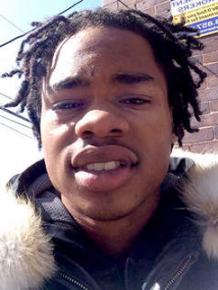Chicago police justify another killing
reports from Chicago on another police killing--and the angry response.
RAASON "LIL B" SHAW was chased down and shot to death by Chicago police on March 29 in the Woodlawn neighborhood on Chicago's South Side.
The police claim the shooting was justified. They say Shaw was seen participating in a suspected drug transaction. When officers confronted him, he fled the scene. Police claim they cornered him in the gangway between two buildings, and Shaw drew .40 caliber Glock handgun, with an extended magazine and laser sight attachment, and pointed it at the officers who then opened fire.
But the more than 100 people who gathered in protest afterward near the site of the killing contradict the police version of events--and residents of Woodlawn, a working class and poor Black neighborhood located a few blocks west of the esteemed University of Chicago, confirm that there are many reasons to be suspicious of another CPD claim that their officers acted in self-defense when they killed another African American youth.
Friends of Shaw say he didn't have a weapon on him at the time he was confronted. Woodlawn resident Tony Smith, who lives a block away from where Shaw was killed, said a street dealer wouldn't be likely to have a weapon and drugs on him at the same time. Even if he did, Smith said, it's even less likely that a street dealer would possess a sophisticated weapon like the one police claim they found at the scene.

Shaw's friends told reporters he was shot seven times in the back--which also casts doubt on the cops' story that Shaw pointed a weapon at the officers chasing him.
Other residents doubt the CPD's claim that officers witnessed a supposed "hand-to-hand narcotics transaction." According to Woodlawn natives, police use any physical contact between pedestrians as an excuse to move in. "You can't even pass a cigarette to somebody without the police jumping on you," said one resident.
Shaw's family members told reporters he probably ran because he knew he was wanted a for missing a court date on a misdemeanor criminal trespass charge. Shamika Jordan, who hired Shaw to clean out foreclosed houses, told ABC News: "He had a troubled past, but he was trying to get his life together. He had started working. Comes to work every day on time. I had no complaints about him."
POLICE SHOOTINGS and harassment are all too common in communities of color like Woodlawn. Residents interviewed after the shooting described aggressive police tactics, used against all residents, but especially larger groups of young Black people, particularly young men.
Woodlawn has high levels of crime, including violence connected to drugs. But Tony Smith challenged the police and media story that this is the result of a "few bad seeds." He had a one-word answer for the source of Woodlawn's high crime rate: "Poverty." Crime is the result of the economic starvation of communities like Woodlawn--lack of resources and opportunities put pressure on poor and working class residents to resort to alternative means to survive.
Increased police repression is a part of the problem, not a solution. The cops are dispatched to low-income neighborhoods not to prevent crime, but to contain the poor and squelch discontent. Harassment and violence is epidemic in areas suffering decreased resources for education, well paying jobs and decent housing.
The question for working class and poor communities of color is: What must be done? What needs to occur to begin to solve some of the problems affecting them, such as police violence, substandard housing, job scarcity, poor educational opportunities and weak political representation?
In the days after the shooting death of Raason Shaw, the Woodlawn community took bold action by taking to the street and protesting the police. Notably, these protests crossed gang lines without incident. More communities of color need to protest racist policing.
Speaking out against racist policies and the racist policing that enforces them can galvanize the community into fighting for broader issues, like jobs, substandard housing, schools and the capitalist system that creates them.
Communities of color can't expect help that they need from police or politicians or the business community. As South Side political activist Zenobia Spencer put it, "We need a mass revolutionary movement--one that isn't scared to stand up for our rights, one that is built and controlled by the people, for all people."


